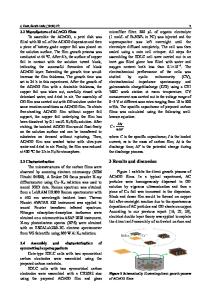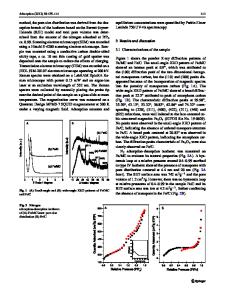Magnetic graphene oxide-biomass activated carbon composite for dye removal
- PDF / 643,946 Bytes
- 13 Pages / 595 x 842 pts (A4) Page_size
- 27 Downloads / 440 Views
pISSN: 0256-1115 eISSN: 1975-7220
INVITED REVIEW PAPER
INVITED REVIEW PAPER
Magnetic graphene oxide-biomass activated carbon composite for dye removal Tan Yan Ying*, Abdul Aziz Abdul Raman*,†, Mustapha Mohammed Bello**, and Archina Buthiyappan* *Department of Chemical Engineering, Faculty of Engineering, University of Malaya, 50603 Kuala Lumpur, Malaysia **Centre for Dryland Agriculture, Bayero University, P.M.B. 3011, Kano State, Nigeria (Received 17 April 2020 • Revised 30 June 2020 • Accepted 7 July 2020) AbstractA magnetic composite was synthesized using palm kernel shell-based activated carbon, graphene oxide (GO) and iron oxide. The morphology, textural properties, magnetic properties, crystal structure and functional groups of the composite were studied. The characterization shows the successful formation of the ternary composite with a high specific surface area (280.39 m2/g) and abundant surface functional groups. The magnetic properties of the composite indicate a saturation magnetization of 33.72 emu/g, signifying that the composite can be easily separated with an external magnetic field. The performance of the composite was then investigated through the removal of an anionic azo dye, Acid Blue 113, from aqueous solution. The effect of initial pH of the solution, adsorbent dosage and adsorption contact time was studied. The composite achieved an adsorption capacity of 32.2 mg/g and 96.3% dye removal. Effective dye removal was still achieved after five cycles of adsorption-regeneration, with the dye removal of 74% after the fifth cycle. The analyses of adsorption isotherm and kinetics show that the adsorption process fits pseudo-secondorder kinetic and Langmuir isotherm models, indicating a monolayer chemisorption process. The excellent adsorption performance and reusability of the composite and its magnetic separability signify its potential as an adsorbent for wastewater treatment. Keywords: Adsorption, Modified Graphene Oxide, Iron Oxide, Palm Kernel Shell, Acid Blue 113
vated carbon [23], have been investigated. Recently, graphene oxide (GO), a carbon-based material, has received considerable interest as a potential adsorbent due to its high specific surface area and the existence of various functional groups, including carboxyl, hydroxyl and epoxy on its surface [2427]. However, unavoidable agglomeration, stacking during application and difficulty in post-treatment separation hinder the practical application of GO as an adsorbent [28]. Therefore, modification of GO is often necessary to enhance its properties and performance [29]. Consequently, various modifications of GO to address these drawbacks have been reported. Examples of these include the use of natural polymers such as chitosan to enhance its adsorption capacity and stability [30,31], and iron oxide to enhance its separability [32,33]. Ali et al. [34] have provided a critical review on the modifications of graphene, including functionalized graphene, graphene-based composites and their applications in removing pollutants from wastewate
Data Loading...











